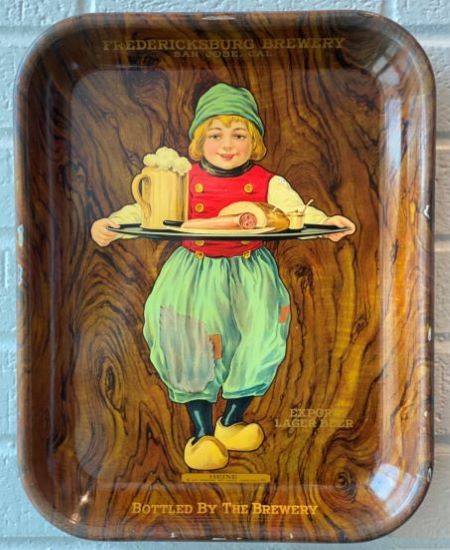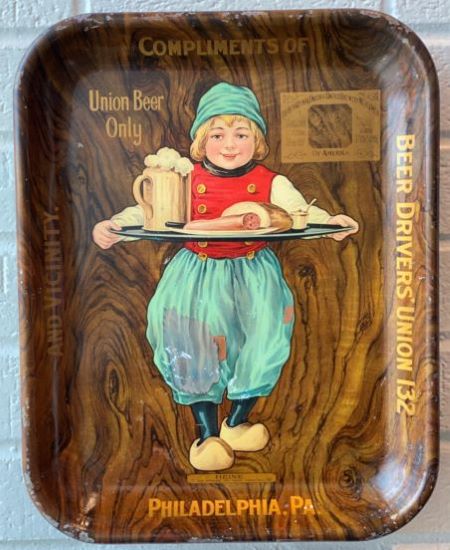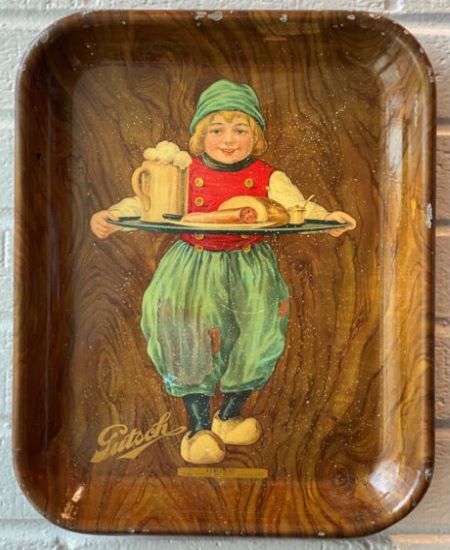The 'Stock' Exchange
American Art Works: No. 142 "Heine"
American Art Works: No. 142 "Heine"
Date: 1915 to 1920
Size: 10.5" x 13.55"
Type: Pie
Scarcity: Common
Value: $$ to $$$
Condition & Brewer Dependent
Size: 10.5" x 13.55"
Type: Pie
Scarcity: Common
Value: $$ to $$$
Condition & Brewer Dependent


General Comments
"Heine" (No. 142) is the companion tray to “A Helping Hand” (No. 139), which although fairly common was not quite as popular. “Heine” is the diminutive for the formal name “Heinrich” which is German/Dutch for Henry, which seems appropriate for the child depicted in this design. It’s meaning variously gets interpreted as “home of the king” or “home ruler.” Heinrich was popular among continental royalty, being the name of seven German kings, starting with the 10th-century Henry I the Fowler, and four French kings. In France it was usually rendered Henri from the Latin form Henricus. The Normans introduced the French form to England, and it was subsequently used by eight kings, ending with the infamous Henry VIII in the 16th century.
"Heine" (No. 142) is the companion tray to “A Helping Hand” (No. 139), which although fairly common was not quite as popular. “Heine” is the diminutive for the formal name “Heinrich” which is German/Dutch for Henry, which seems appropriate for the child depicted in this design. It’s meaning variously gets interpreted as “home of the king” or “home ruler.” Heinrich was popular among continental royalty, being the name of seven German kings, starting with the 10th-century Henry I the Fowler, and four French kings. In France it was usually rendered Henri from the Latin form Henricus. The Normans introduced the French form to England, and it was subsequently used by eight kings, ending with the infamous Henry VIII in the 16th century.

During the later Middle Ages, it was fairly popular, and was generally rendered as Harry or Herry in English pronunciation. However, traditional German names of this ilk have had a difficult time emigrating into the American name pool, mostly because anti-German sentiment during the two world wars of the 20th century drove German names out of fashion. And it doesn’t help that a slang meaning of 'heinie' (slightly different spelling) means buttocks.
Like No. 139, Heine is wearing what apparently is meant to be traditional “Dutch” grab with similar colors and wooden shoes but of a noticeably shabbier condition. His tray carries a larger stein of beer, a large sausage, and a loaf of bread instead of the more refined sandwich on No. 139; both have a traditional small crock of mustard. Surprisingly, although similar, the woodgrain pattern is different than the one on No. 139; it does however extend continuous from the face through the rim to the edge of the tray. Reviewing all of the woodgrain trays starting with “San Toy (No. 114), each of them has its own unique woodgrain pattern.
Like No. 139, Heine is wearing what apparently is meant to be traditional “Dutch” grab with similar colors and wooden shoes but of a noticeably shabbier condition. His tray carries a larger stein of beer, a large sausage, and a loaf of bread instead of the more refined sandwich on No. 139; both have a traditional small crock of mustard. Surprisingly, although similar, the woodgrain pattern is different than the one on No. 139; it does however extend continuous from the face through the rim to the edge of the tray. Reviewing all of the woodgrain trays starting with “San Toy (No. 114), each of them has its own unique woodgrain pattern.




"Heine" No. 142
"A Helping Hand" No. 139
"San Toy" No. 114
75% of the companies that used the “Heine” design had previously used No. 139, although it had twice the number of users in total.
Sahling does have an entry in September 1914 for “Dutch Boy stock tray” in his workbook, although the copyright date that appears on the design is 1915.
Size, Shape and Message Placement
Every example that we’ve seen of this design has been a small oblong tray (11" x13") with the single exception of a framed print (we are uncertain if it was on paper or tin). As noted above, the rim is a continuation of the woodgrain pattern of the face and advertising text is gold. There are more example of advertising text on the face with this design than with No. 139.
Hager & Price
As mentioned previously, Hager stopped commenting on individual trays after No. 136, but he does it include No. 142 in both his date of introduction table (1915) and his catalog. “Heine” was most popular with brewers with the only exceptions being for soda and whiskey makers, as well as Beer Drivers Union 132. Only exceptional examples reach three figures; the one exception being a well below average example for Ortlieb Brewing’s Mauch Chunk location which reach mid-three figures. Most other examples (brewers and non-brewers) range from low to mid-double figures.
Sahling does have an entry in September 1914 for “Dutch Boy stock tray” in his workbook, although the copyright date that appears on the design is 1915.
Size, Shape and Message Placement
Every example that we’ve seen of this design has been a small oblong tray (11" x13") with the single exception of a framed print (we are uncertain if it was on paper or tin). As noted above, the rim is a continuation of the woodgrain pattern of the face and advertising text is gold. There are more example of advertising text on the face with this design than with No. 139.
Hager & Price
As mentioned previously, Hager stopped commenting on individual trays after No. 136, but he does it include No. 142 in both his date of introduction table (1915) and his catalog. “Heine” was most popular with brewers with the only exceptions being for soda and whiskey makers, as well as Beer Drivers Union 132. Only exceptional examples reach three figures; the one exception being a well below average example for Ortlieb Brewing’s Mauch Chunk location which reach mid-three figures. Most other examples (brewers and non-brewers) range from low to mid-double figures.
Confirmed Brewer used Stock Trays
Non-Beer Related & Non-Tray Uses
Click the Picture to Return to Meek & Beach Stock Catalog Page











